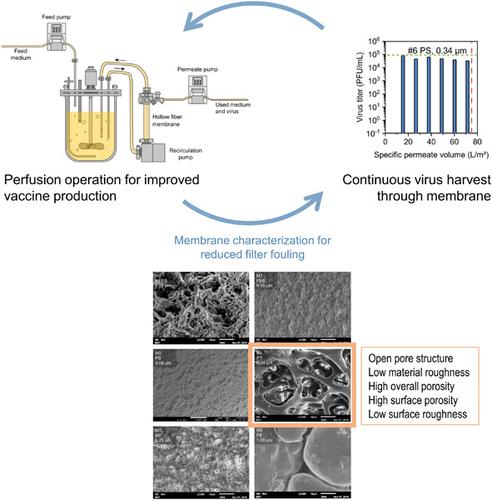当前位置:
X-MOL 学术
›
Biotechnol. Bioeng.
›
论文详情
Our official English website, www.x-mol.net, welcomes your
feedback! (Note: you will need to create a separate account there.)
Virus harvesting in perfusion culture: Choosing the right type of hollow fiber membrane.
Biotechnology and Bioengineering ( IF 3.5 ) Pub Date : 2020-06-22 , DOI: 10.1002/bit.27470 Alexander Nikolay 1 , Joris de Grooth 2 , Yvonne Genzel 1 , Jeffery A Wood 3 , Udo Reichl 1, 4
Biotechnology and Bioengineering ( IF 3.5 ) Pub Date : 2020-06-22 , DOI: 10.1002/bit.27470 Alexander Nikolay 1 , Joris de Grooth 2 , Yvonne Genzel 1 , Jeffery A Wood 3 , Udo Reichl 1, 4
Affiliation

|
The use of bioreactors coupled to membrane‐based perfusion systems enables very high cell and product concentrations in vaccine and viral vector manufacturing. Many virus particles, however, are not stable and either lose their infectivity or physically degrade resulting in significant product losses if not harvested continuously. Even hollow fiber membranes with a nominal pore size of 0.2 µm can retain much smaller virions within a bioreactor. Here, we report on a systematic study to characterize structural and physicochemical membrane properties with respect to filter fouling and harvesting of yellow fever virus (YFV; ~50 nm). In tangential flow filtration perfusion experiments, we observed that YFV retention was only marginally determined by nominal but by effective pore sizes depending on filter fouling. Evaluation of scanning electron microscope images indicated that filter fouling can be reduced significantly by choosing membranes with (i) a flat inner surface (low boundary layer thickness), (ii) a smooth material structure (reduced deposition), (iii) a high porosity (high transmembrane flux), (iv) a distinct pore size distribution (well‐defined pore selectivity), and (v) an increased fiber wall thickness (larger effective surface area). Lowest filter fouling was observed with polysulfone (PS) membranes. While the use of a small‐pore PS membrane (0.08 µm) allowed to fully retain YFV within the bioreactor, continuous product harvesting was achieved with the large‐pore PS membrane (0.34 µm). Due to the low protein rejection of the latter, this membrane type could also be of interest for other applications, that is, recombinant protein production in perfusion cultures.
中文翻译:

灌注培养中的病毒收获:选择正确类型的中空纤维膜。
将生物反应器与基于膜的灌注系统结合使用,可以在疫苗和病毒载体制造中实现非常高的细胞和产品浓度。然而,许多病毒颗粒不稳定,如果不连续收获,要么失去传染性,要么物理降解,导致产品大量损失。即使标称孔径为 0.2 µm 的中空纤维膜也可以在生物反应器内保留更小的病毒粒子。在这里,我们报告了一项系统研究,以表征与过滤器污染和黄热病病毒 (YFV;~50 nm) 收获相关的结构和物理化学膜特性。在切向流过滤灌注实验中,我们观察到 YFV 保留仅由标称值决定,但由取决于过滤器污垢的有效孔径大小决定。i ) 平坦的内表面(低边界层厚度),(ii)光滑的材料结构(减少沉积),(iii)高孔隙率(高跨膜通量),(iv)明显的孔径分布(明确的孔选择性),和(v) 增加的纤维壁厚(更大的有效表面积)。使用聚砜 (PS) 膜观察到最低的过滤器污垢。虽然使用小孔 PS 膜 (0.08 µm) 可以将 YFV 完全保留在生物反应器内,但使用大孔 PS 膜 (0.34 µm) 实现了连续的产品收获。由于后者的蛋白质排斥率低,这种膜类型也可用于其他应用,即灌注培养中的重组蛋白质生产。
更新日期:2020-06-22
中文翻译:

灌注培养中的病毒收获:选择正确类型的中空纤维膜。
将生物反应器与基于膜的灌注系统结合使用,可以在疫苗和病毒载体制造中实现非常高的细胞和产品浓度。然而,许多病毒颗粒不稳定,如果不连续收获,要么失去传染性,要么物理降解,导致产品大量损失。即使标称孔径为 0.2 µm 的中空纤维膜也可以在生物反应器内保留更小的病毒粒子。在这里,我们报告了一项系统研究,以表征与过滤器污染和黄热病病毒 (YFV;~50 nm) 收获相关的结构和物理化学膜特性。在切向流过滤灌注实验中,我们观察到 YFV 保留仅由标称值决定,但由取决于过滤器污垢的有效孔径大小决定。i ) 平坦的内表面(低边界层厚度),(ii)光滑的材料结构(减少沉积),(iii)高孔隙率(高跨膜通量),(iv)明显的孔径分布(明确的孔选择性),和(v) 增加的纤维壁厚(更大的有效表面积)。使用聚砜 (PS) 膜观察到最低的过滤器污垢。虽然使用小孔 PS 膜 (0.08 µm) 可以将 YFV 完全保留在生物反应器内,但使用大孔 PS 膜 (0.34 µm) 实现了连续的产品收获。由于后者的蛋白质排斥率低,这种膜类型也可用于其他应用,即灌注培养中的重组蛋白质生产。











































 京公网安备 11010802027423号
京公网安备 11010802027423号